Possibilities for Mitigating Coastal Erosion in the Downdrift Zone of Port Jetties Using Nearshore Nourishment: A Case Study of Klaipėda Port, Lithuania
Abstract
1. Introduction
2. Study Area
3. Materials and Methods
4. Results
4.1. Nourishment Data Analysis
4.2. Post-Nourishment Sediment Transport in the Nearshore Zone
4.3. Post-Nourishment Changes in the Beach Sand Grain Size
5. Discussion
5.1. Nearshore vs. Beach Nourishment
5.2. The Influence of Nourishment on the State of the Beach
5.3. Selection of the Optimal Nourishment Depth and Artificial Sandbar Morphology
6. Conclusions
Author Contributions
Funding
Data Availability Statement
Acknowledgments
Conflicts of Interest
References
- Spodar, A.; Héquette, A.; Ruz, M.H.; Cartier, A.; Grégoire, P.; Sipka, V.; Forain, N. Evolution of a beach nourishment project using dredged sand from navigation channel, Dunkirk, northern France. J. Coast. Conserv. 2018, 22, 457–474. [Google Scholar] [CrossRef]
- Marinho, B.; Carlos Coelho, C.; Magnus Larson, M.; Hans Hanson, H. Monitoring the evolution of nearshore nourishments along Barra-Vagueira coastal stretch, Portugal. Ocean Coast. Manag. 2018, 157, 23–39. [Google Scholar] [CrossRef]
- Luijendijk, A.; Hagenaars, G.; Roshanka Ranasinghe, R.; Baart, F.; Donchyts, G.; Aarninkhof, S. The State of the World’s Beaches. Sci. Rep. 2018, 8, 6641. [Google Scholar] [CrossRef]
- Lämmle, L.; Perez Filho, A.; Donadio, C.; Arienzo, M.; Ferrara, L.; Santos, C.d.J.; Souza, A.O. Anthropogenic Pressure on Hydrographic Basin and Coastal Erosion in the Delta of Paraíba do Sul River, Southeast Brazil. J. Mar. Sci. Eng. 2022, 10, 1585. [Google Scholar] [CrossRef]
- Chowdhury, P.; Lakku, N.K.G.; Lincoln, S.; Seelam, J.K.; Behera, M.R. Climate change and coastal morphodynamics: Interactions on regional scales. Sci. Total Environ. 2023, 899, 166432. [Google Scholar]
- Brunn, P. The Development of Downdrift Erosion. J. Coast. Res. 1995, 11, 1242–1257. [Google Scholar]
- Elmoustapha, A.O.; Levoy, F.; Manfort, O.; Koutitonsky, V.G. A numerical forecast of shoreline evolution after harbour construction in Nouakchott, Mauritania. J. Coast. Res. 2007, 236, 1409–1417. [Google Scholar] [CrossRef]
- Pupienis, D.; Jonuškaitė, S.; Jarmalavičius, D.; Žilinskas, G. Klaipėda port jetties impact on the Baltic Sea shoreline dynamics, Lithuania. J. Coast. Res. 2013, 165, 2167–2172. [Google Scholar] [CrossRef]
- Lim, K.C.H.; Hwang, S.; Lee, J.L. An analytical model for beach erosion downdrift of groins: Case study of Jeongdongjin Beach. Earth Surf. Dyn. 2022, 10, 151–163. [Google Scholar] [CrossRef]
- Franklin, G.L.; Medellin, G.; Appendini, C.H.M.; Gómez, J.A.; Torres-Freyermuth, A.; González, J.L.; Ruiz-Salcines, P. Impact of port development on the northern Yucatan Peninsula coastline. Reg. Stud. Mar. Sci. 2021, 45, 101835. [Google Scholar] [CrossRef]
- Szmytkiewicz, M.; Biegowski, J.; Kaczmarek, L.M.; Okroj, T.; Ostrowski, R.; Pruszak, Z.; Rozynsky, G.; Skaja, M. Coastline changes nearby harbour structures: Comparative analysis of one-line models versus field data. Coast. Eng. 2000, 40, 119–139. [Google Scholar]
- Pruszak, Z. Polish coast—Two cases of human impact. Baltica 2004, 17, 34–40. [Google Scholar]
- Babakov, A.N.; Chuburenko, B.V. The Structure of the Net Alongshore Sediment Transport in the Eastern Gulf of Gdansk. Water Resour. 2019, 46, 515–529. [Google Scholar] [CrossRef]
- Kriaučiūnienė, J.; Žilinskas, G.; Pupienis, D.; Jarmalavičius, D.; Gailiušis, B. Impact of Šventoji port jetties on coastal dynamics of the Baltic Sea. J. Environ. Eng. Landsc. Manag. 2013, 21, 114–122. [Google Scholar] [CrossRef]
- Žilinskas, G.; Janušaitė, R.; Jarmalavičius, D.; Pupienis, D. The impact of Klaipėda Port entrance channel dredging on the dynamics of coastal zone, Lithuania. Oceanologia 2020, 62, 489–500. [Google Scholar] [CrossRef]
- Eberhards, G.; Lapinskis, J. Processes on the Latvian Coast of the Baltic Sea; Atlas: Riga, Latvia, 2008. [Google Scholar]
- Tönisson, H.; Mannikus, R.; Kont, A.; Palginomm, V.; Alari, V.; Suuroja, S.; Vaasma, T.; Vilumaa, K. Application of Shore Sediments Accumulated in Navigation Channel for Restoration of Sandy Beaches around Parnu City, SW Estonia, Baltic Sea. J. Mar. Sci. Eng. 2024, 12, 394. [Google Scholar] [CrossRef]
- Balaji, R.; Kumar, S.S.; Misra, A. Understanding the effects of seawall construction using a combination of analytical modelling and remote sensing techniques: Case study of Fansa, Gujarat, India. J. Ocean Clim. Syst. 2017, 8, 153–160. [Google Scholar] [CrossRef]
- Tang, J.; Lyu, Y.; Shen, Y.; Zhang, M.; Su, M. Numerical study on influences of breakwater layout on coastal waves, wave-induced currents, sediment transport and beach morphological evolution. Ocean Eng. 2017, 141, 375–387. [Google Scholar] [CrossRef]
- Basinski, T. Protection of the Hel Spit. J. Coast. Res. 1995, 22, 197–201. [Google Scholar]
- Losada, M.A.; Medina, R.; Vidal, C.; Losada, I.J. History of coastal engineering in Spain. In History and Heritage of Coastal Engineering; American Society of Civil Engineers: Reston, VA, USA, 1996; pp. 465–499. [Google Scholar]
- Hamm, L.; Capobianco, M.; Dette, H.H.; Lechuga, A.; Spanhoff, R.; Stive, M.J.F. A summary of European experience with shore nourishment. Coast. Eng. 2002, 47, 237–264. [Google Scholar] [CrossRef]
- Wang, Y.H.; Wang, Y.H.; Deng, A.J.; Feng, H.C.; Wang, D.W. Emerging Downdrift Erosion by Twin Long-Range Jetties on an Open Mesotidal Muddy Coast, China. J. Mar. Sci. Eng. 2022, 10, 570. [Google Scholar] [CrossRef]
- Saengsupavanich, C. Willingness to restore jetty-created erosion at a famous tourism beach. Ocean Coast. Manag. 2019, 178, 104817. [Google Scholar] [CrossRef]
- Bax, V.; van de Lageweg, W.I.; de Groot, S.; Moerbeek, W. Beach user perspectives on the upscaling of sand nourishments in response to sea level rise—A discrete choice experiment. Ocean Coast. Manag. 2024, 253, 107139. [Google Scholar] [CrossRef]
- Nordstrom, K.F.; Jackson, N.L.; Farrell, E.J.; Rafferty, P.; Tengwall, C. Restoring sediment to compensate for human-induced erosion of an estuarine shore. Geomorphology 2016, 262, 37–46. [Google Scholar] [CrossRef]
- Ludka, B.C.; Guza, R.T.; O’Reilly, W.G. Nourishment evolution and impacts at four southern California beaches: A sand volume analysis. Coast. Eng. 2018, 136, 96–105. [Google Scholar] [CrossRef]
- Johnson, C.L.; McFall, B.C.; Krafft, D.R.; Brown, M.E. Sediment Transport and Morphological Response to Nearshore Nourishment Projects on Wave-Dominated Coasts. J. Mar. Sci. Eng. 2021, 9, 1182. [Google Scholar] [CrossRef]
- Mendes, D.; Pais-Barbosa, J.; Baptista, P.; Silva, P.A.; Bernardes, C.; Pinto, C. Beach Response to a Shoreface Nourishment (Aveiro, Portugal). J. Mar. Sci. Eng. 2021, 9, 1112. [Google Scholar] [CrossRef]
- Pinto, C.A.; Taborda, R.; Andrade, C.; Baptista, P.; Silva, P.A.; Mendes, D.; Pais-Barbosa, J. Morphological Development and Behaviour of a Shoreface Nourishment in the Portuguese Western Coast. J. Mar. Sci. Eng. 2022, 10, 146. [Google Scholar] [CrossRef]
- Jarmalavičius, D.; Žilinskas, G.; Pupienis, D. Impact of Klaipėda port jetties reconstruction on adjacent sea coast dynamics. J. Environ. Eng. Landsc. Manag. 2012, 20, 240–247. [Google Scholar] [CrossRef]
- Pustelnikovas, O.; Nesterova, M. Environmental Effects of aBlack Oil Spill in the Baltic Sea. Biogeochemistry, Geology and Paleogeography of the Baltic Sea Series; Academy of Sciences of the Lithuanian SSR Department of Geography; Academy of Sciences of the USSR P. Shirshov Institute of Oceanology: Vilnius, Lithuania, 1984; Volume 2. [Google Scholar]
- Kirlys, V. Impact of extreme storms on the shallow and sandy coasts of the South-Eastern Baltic. Coast. Dyn. Paleogeography Balt. Sea 1990, 1, 83–96. [Google Scholar]
- Brand, E.; Ramaekers, G.; Lodder, Q. Dutch experience with sand nourishments for dynamic coastline conservation—An operational overview. Ocean Coast. Manag. 2022, 217, 106008. [Google Scholar] [CrossRef]
- King, C.A.M. Beaches and Coasts; Arnold: London, UK, 1959. [Google Scholar]
- Winant, C.D.; Inman, D.L.; Nordstrom, C.E. Description of seasonal beach changes using empirical eigenfunctions. J. Geophys. Res. 1975, 80, 1979–1986. [Google Scholar]
- Hallermeier, R.J. A profile zonation for seasonal sand beaches from wave climate. Coast. Eng. 1980, 4, 253–277. [Google Scholar] [CrossRef]
- Žilinskas, G.; Jarmalavičius, D.; Pupienis, D. The influence of natural and anthropogenic factors on grain size distribution along the southeastern Baltic spits. Geol. Q. 2018, 62, 375–384. [Google Scholar] [CrossRef]
- James, W.R. Techniques in Evaluating Suitability of Borrow Material for Beach Nourishment; U.S. Army Corps of Engineers Coastal Engineering Research Center: Vicksburg, MS, USA, 1975; Volume 60. [Google Scholar]
- Shore Protection Manual; Coastal Engineering Research Center. US. Army Corps of Engineers, Waterways Experiment Station: Vicksburg, MS, USA, 1984.
- Dean, R.G.; Campbell, T.J. Beach nourishment. In Handbook of Ocean Engineering; Springer: Berlin/Heidelberg, Germany, 2016; pp. 635–652. [Google Scholar] [CrossRef]
- Van der Spek, A.J.F.; de Kruif, A.C.; Spanhoff, R. Guidelines for Shoreface Nourishments; RIKZ-rapport; Rijswaterstaat: Utrecht, The Netherlands, 2007; ISBN 978-90-369-5764-9. (In Dutch) [Google Scholar]
- Maa, J.P.-Y.; Hobbs, C.H.; Hardaway, C.S., Jr. A criterion for determining the impact on shorelines caused by altering wave transformation. J. Coast. Res. 2001, 17, 107–113. [Google Scholar]
- Work, P.A.; Fehrenbacher, F.; Voulgaris, G. Nearshore impacts of dredging for beach nourishment. J. Waterw. Port Coast. Ocean Eng. 2004, 130, 303–311. [Google Scholar] [CrossRef]
- Žilinskas, G.; Jarmalavičius, D.; Pupienis, D. The influence of nourishment of nearshore sediment supplies on the coast. Geogr. Metraštis 2003, 36, 89–100. [Google Scholar]
- Vermaas, T.; De Bruijn, R.; Vonhögen-Peeters, L. Ontwikkeling Suppletie Heemskerk 2011–2016; Deltares Rapport Nr. 1230043-001; Rijswaterstaat: Utrecht, The Netherlands, 2017. [Google Scholar]

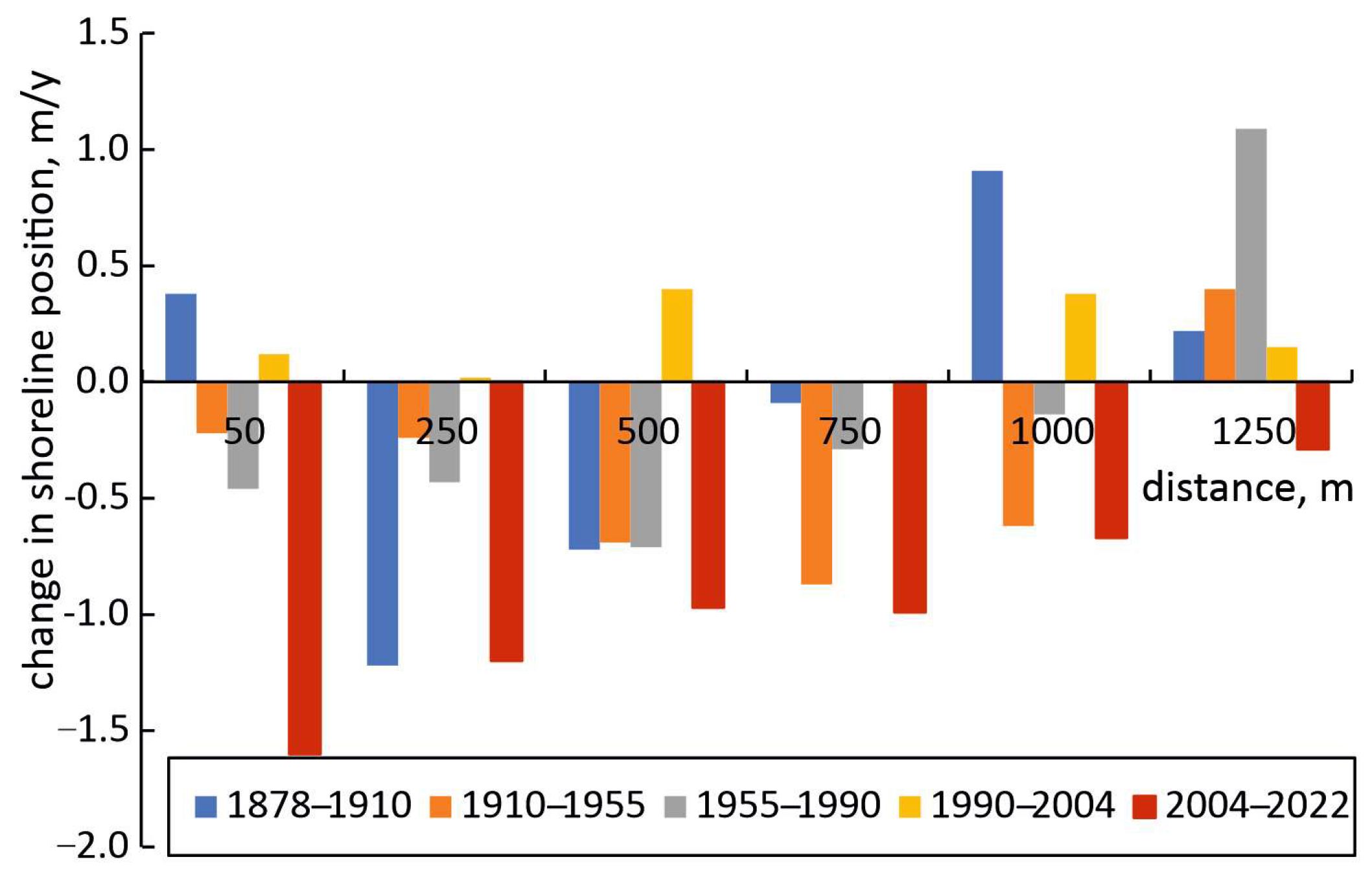
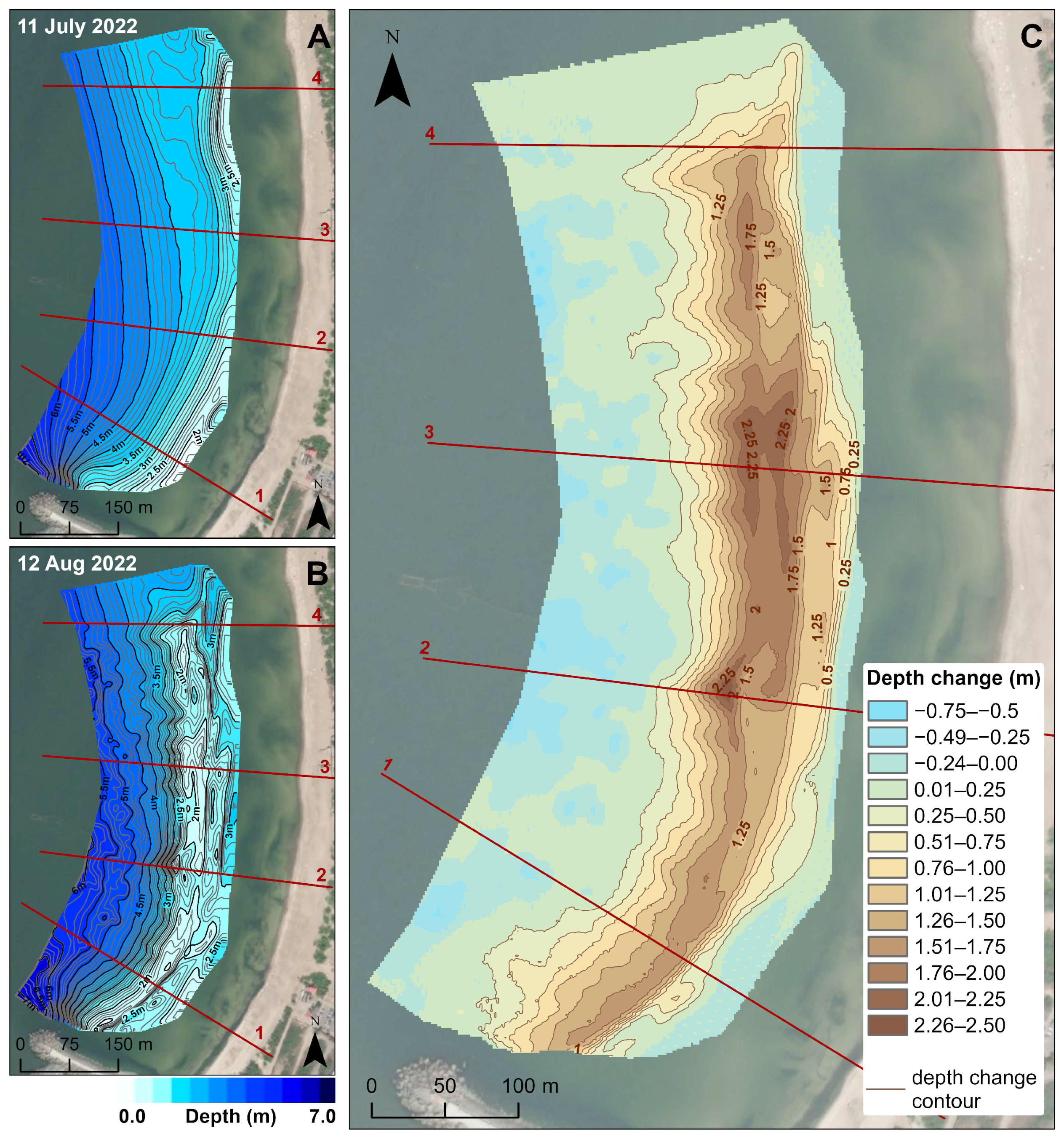

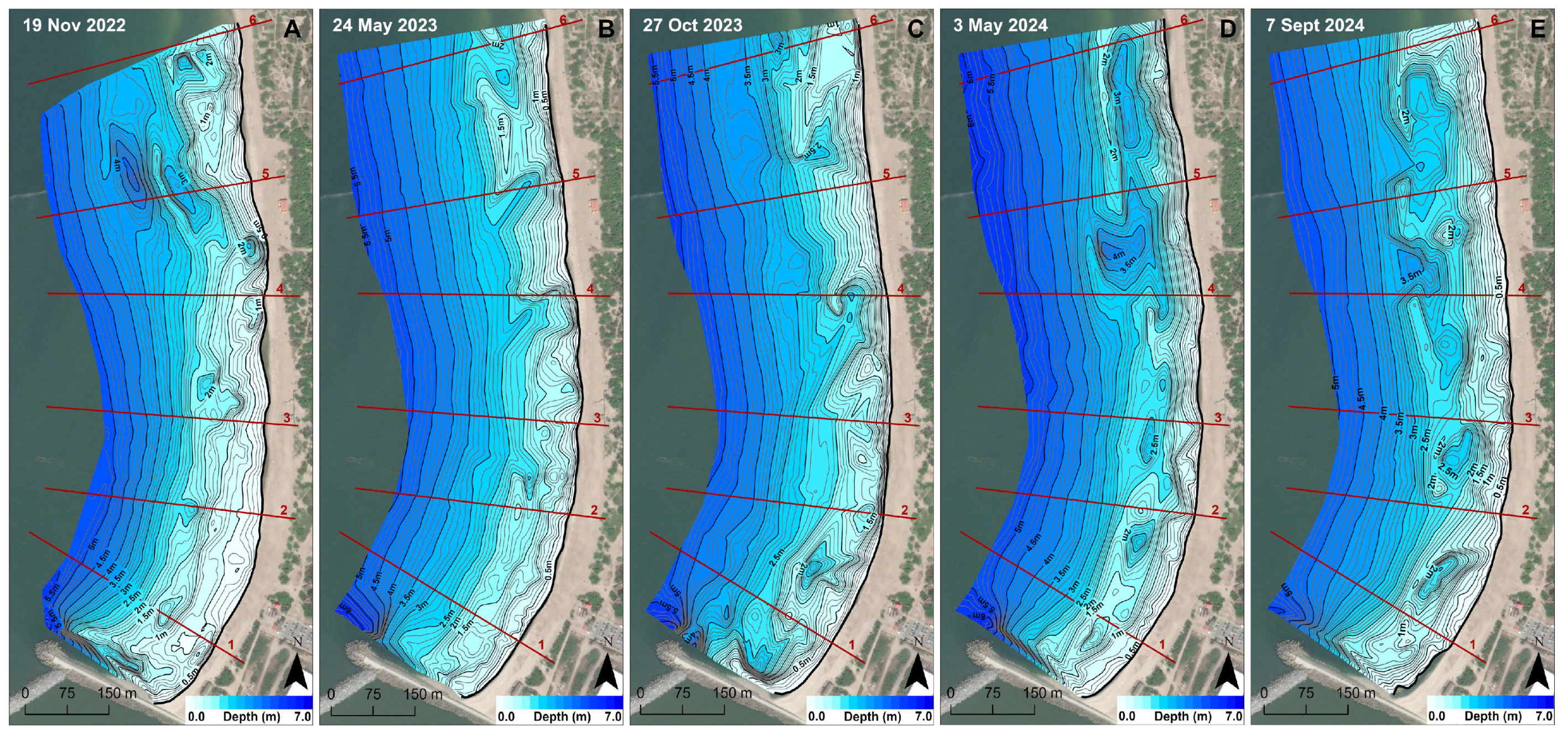
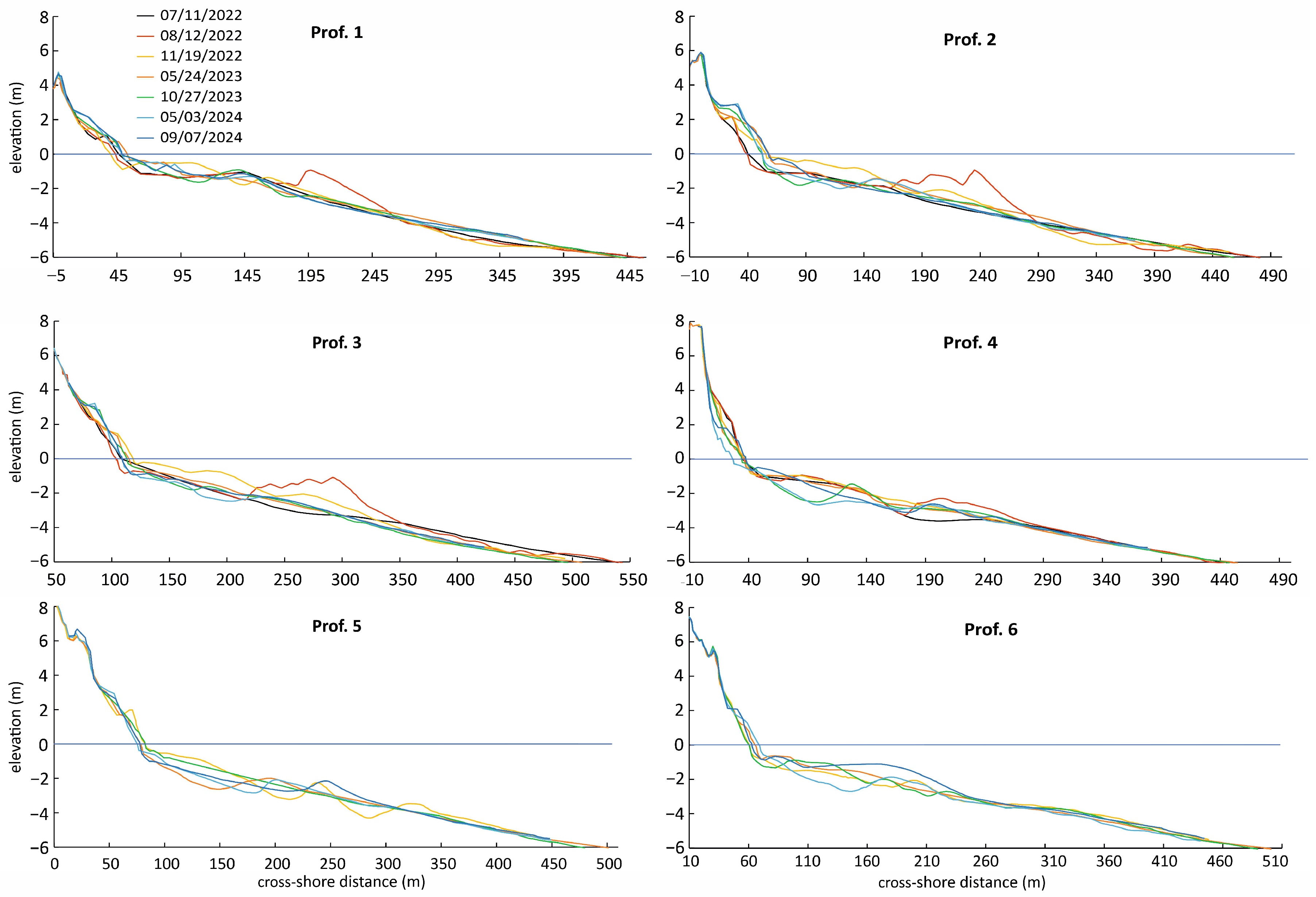
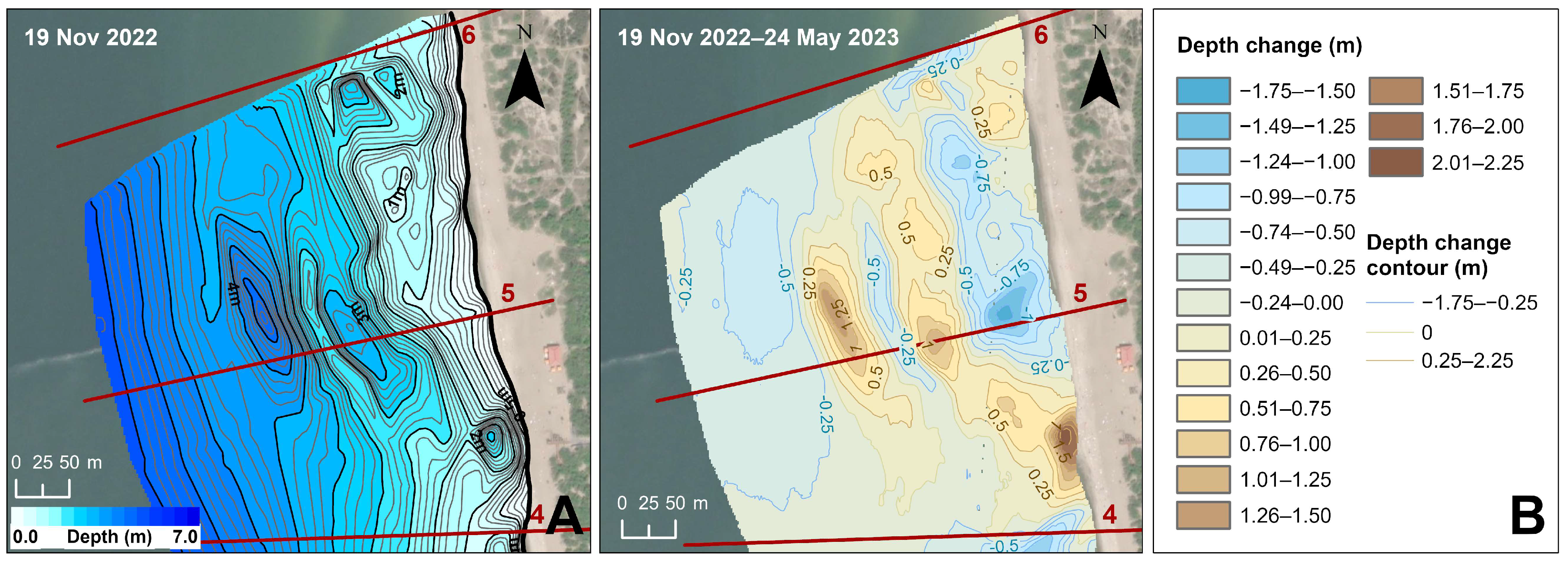


| Date | Southern Sector | Northern Sector 3 |
|---|---|---|
| Nearshore/Beach | Nearshore/Beach | |
| 12 Aug 2022–19 Nov 2022 | +30,850/+1900 | -/−1100 |
| 19 Nov. 2022–24 May 2023 | −44,590/+7990 | −13,800/−8030 |
| 24 May 2023–27 Oct 2023 | −9370/+840 | −3360/+850 |
| 27 Oct 2023–03 May 2024 | −1820/+610 | −20,250/−2340 |
| 3 May 2024–7 Sept 2024 | +20,800/+5390 | +18,980/+2470 |
| Date | Southern Sector | Northern Sector | ||||
|---|---|---|---|---|---|---|
| Distance from Jetty, m | ||||||
| 150 | 400 | 560 | 790 | 1020 | 1300 | |
| 12 Aug 2022 | 0.0 | 0.0 | 0.0 | 0.0 | 0.0 | 0.0 |
| 08 Sept 2022 | 2.0 | 1.0 | 2.0 | −3.0 | −2.0 | 9.0 |
| 19 Nov 2022 | −6.0 | 6.0 | 7.0 | 3.0 | −1.0 | 9.0 |
| 08 May 2023 | 10.0 | 19.0 | 15.0 | 3.0 | −12.0 | −6.0 |
| 27 Oct 2023 | 5.0 | 13.0 | 9.0 | 0.0 | −12.0 | −9.0 |
| 03 May 2024 | 6.0 | 13.0 | 5.0 | −7.0 | −19.0 | −2.0 |
| 07 Sept 2024 | 6.0 | 18.0 | 6.0 | 4.0 | −17.0 | −8.0 |
| Date | Southern Sector | Northern Sector | ||||
|---|---|---|---|---|---|---|
| Distance from Jetty, m | ||||||
| 150 | 400 | 560 | 790 | 1020 | 1300 | |
| 15 Aug 2022 | 0.0 | 0.0 | 0.0 | 0.0 | 0.0 | 0.0 |
| 08 Sept 2022 | 0.1 | 2.0 | 3.6 | −3.0 | 3.4 | 1.2 |
| 19 Nov 2022 | −0.7 | 4.2 | 7.6 | −2.7 | −3.0 | 1.3 |
| 08 May 2023 | 8.4 | 30.2 | 15.6 | −10.3 | −25.5 | 1.5 |
| 27 Oct 2023 | 10.5 | 27.4 | 16.5 | −10.8 | −23.8 | −2.3 |
| 03 May 2024 | 14.6 | 36.6 | 11.6 | −34.5 | −32.9 | 10.3 |
| 07 Sept 2024 | 19.9 | 41.9 | 13.5 | −13.2 | −29.7 | 5.4 |
Disclaimer/Publisher’s Note: The statements, opinions and data contained in all publications are solely those of the individual author(s) and contributor(s) and not of MDPI and/or the editor(s). MDPI and/or the editor(s) disclaim responsibility for any injury to people or property resulting from any ideas, methods, instructions or products referred to in the content. |
© 2025 by the authors. Licensee MDPI, Basel, Switzerland. This article is an open access article distributed under the terms and conditions of the Creative Commons Attribution (CC BY) license (https://creativecommons.org/licenses/by/4.0/).
Share and Cite
Žilinskas, G.; Janušaitė, R.; Jarmalavičius, D.; Jukna, L.; Pupienis, D. Possibilities for Mitigating Coastal Erosion in the Downdrift Zone of Port Jetties Using Nearshore Nourishment: A Case Study of Klaipėda Port, Lithuania. J. Mar. Sci. Eng. 2025, 13, 628. https://doi.org/10.3390/jmse13040628
Žilinskas G, Janušaitė R, Jarmalavičius D, Jukna L, Pupienis D. Possibilities for Mitigating Coastal Erosion in the Downdrift Zone of Port Jetties Using Nearshore Nourishment: A Case Study of Klaipėda Port, Lithuania. Journal of Marine Science and Engineering. 2025; 13(4):628. https://doi.org/10.3390/jmse13040628
Chicago/Turabian StyleŽilinskas, Gintautas, Rasa Janušaitė, Darius Jarmalavičius, Laurynas Jukna, and Donatas Pupienis. 2025. "Possibilities for Mitigating Coastal Erosion in the Downdrift Zone of Port Jetties Using Nearshore Nourishment: A Case Study of Klaipėda Port, Lithuania" Journal of Marine Science and Engineering 13, no. 4: 628. https://doi.org/10.3390/jmse13040628
APA StyleŽilinskas, G., Janušaitė, R., Jarmalavičius, D., Jukna, L., & Pupienis, D. (2025). Possibilities for Mitigating Coastal Erosion in the Downdrift Zone of Port Jetties Using Nearshore Nourishment: A Case Study of Klaipėda Port, Lithuania. Journal of Marine Science and Engineering, 13(4), 628. https://doi.org/10.3390/jmse13040628






